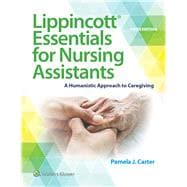Streamline the path to a successful nursing assistant career with this concise, approachable text. Lippincott Essentials for Nursing Assistants: A Humanistic Approach to Caregiving, 5th edition, delivers the foundational concepts and facts that a nursing assistant needs to competently and compassionately function in a long-term care facility, acute care facility, or home health agency.
Ideal for use in shorter, fast-paced programs, each chapter focuses on only the most essential concepts, breaking down information into segments for easier retention. Author Pamela Carter’s conversational, yet professional writing style clarifies complex material to make information more accessible. Helpful Procedures and Guidelines boxes provide step-by-step walkthroughs for common tasks and detail the rationale behind key procedure actions in order to enhance understanding and strengthen clinical decision-making capabilities.
The 5th edition has been revised and updated to reflect today’s changing healthcare practices — including the latest NNAAP® skill revisions and features callouts to Lippincott Acute Care Skills for Advanced Nursing Assistants, a companion ebook-only text by Pamela Carter that highlights advanced skills and situations that may call for additional training as students advance through their nursing assistant careers.








